New Boston Historical Society
New Boston, New Hampshire
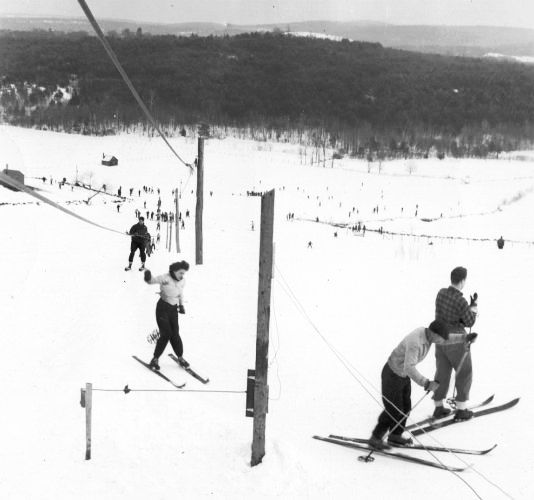
Looking east from the hill above Tucker Mill Road — 1940
New Boston Skiway — Our Town's First Rope Tow
I was very interested in John's email — could he be referring to the "Skiway," New Boston's first ski area? We had a lot of information in our files about our town's second rope tow at Pinball Hill, operated by Walter Kirsch in the 1940s, but only a single blurred photo of its predecessor, the New Boston Skiway, one mile to the northwest.

The hill east of Tucker Mill Road as seen from the Francestown Road
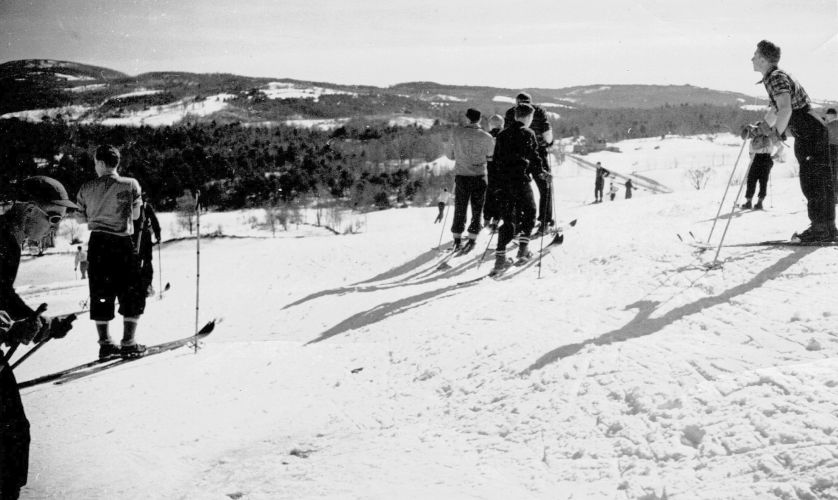
The Francestown Road and the Hechtls' farmhouse can be seen in the distance to the right beyond the skiers.
The 1940 photos were taken by Ed Rahn, who enjoyed photography as well as skiing.
The New Boston Skiway was opened in 1938 by Mike and Louise Connell and Ed and Janet Rahn. (The two women were sisters.) All four were ski enthusiasts who lived in Manchester NH, and they operated the Skiway until 1942. Three of their children joined me at the top of the hill in November 2021, where we met Jim Dodge who explained the farm's history. John's cousin Pat DeGrandpre, who was Ed and Janet's daughter, brought us more photos, newspaper clippings, and the Skiway ledger which provided interesting details of its operation.
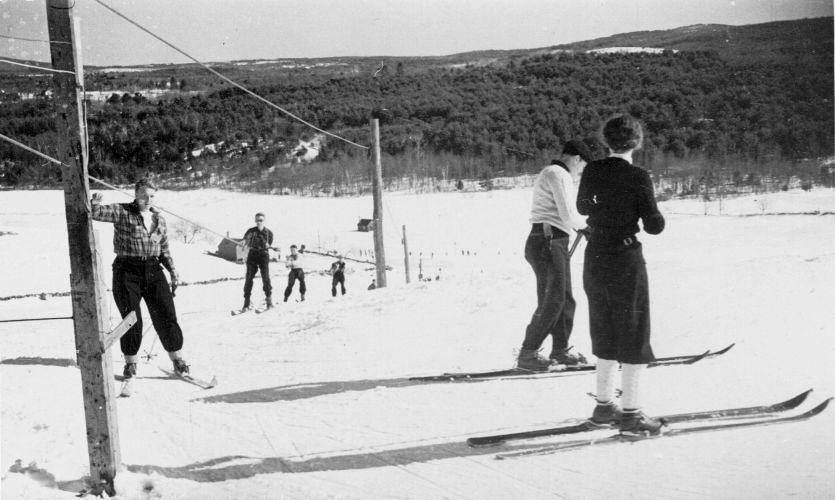
Today the Dodge Farms ice cream stand on the Weare Road (Route 77) is in the trees beyond the slope.
The slope ended in what's now Dodge Pond; beaver dams have made the pond bigger than it was in 1940.
Prior to the invention of the rope tow, downhill skiers had to walk up the slopes for every run, which was time-consuming and hard work, too. A Canadian named Alex Foster built the first rope tow in 1931 at a ski area in Quebec, using pulleys and 2,500 feet of thick rope that he strung between telephone poles just as you might string a clothesline and pulley between two trees. The motivating power was a four-cylinder gas engine from an old Dodge.
In 1934 the first rope tow in the United States was built in Woodstock VT, so the technology was somewhat of a novelty when it arrived in New Boston only four years later. Skiers needed to wear gloves and let the moving rope slip through their fingers at first so they wouldn't get yanked off their skis when they tightened their grip. You went through a lot of gloves in a season, and sometimes hats and loose sweaters too!
There are hundreds of rope tows still in use in the U.S. In fact, ski areas like Ascutney VT are installing new rope tows as an affordable alternative to expensive lift tickets.
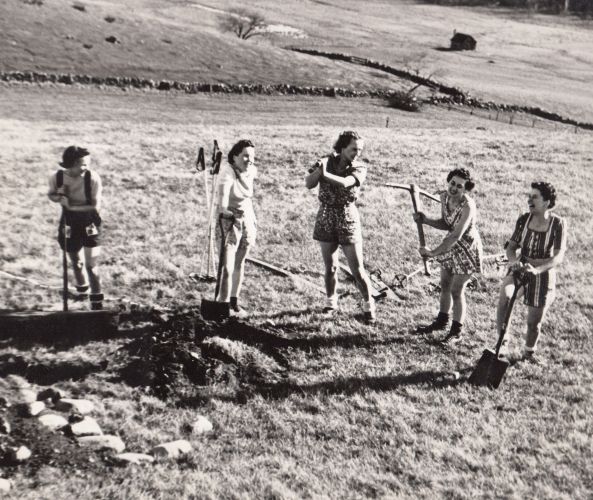
The McMillan sisters Louise (left) and Janet (2nd from right) convinced their friends it would be fun to build a ski tow!
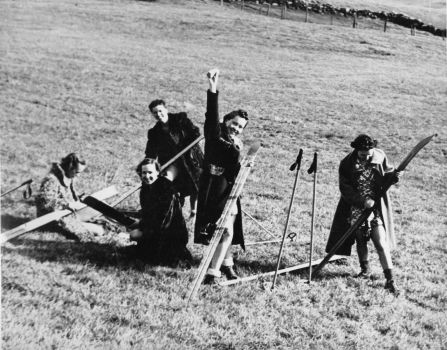

How did the Connells and Rahns decide to operate a ski area in New Boston? Pat remembers that her parents liked to go to Francestown for summer vacations; most likely they would have driven right by the hill where they located their rope tow.
We suspect that it was their partner Sherburne Graves from Plymouth NH who provided the technical knowledge and some of the equipment. An entry in the New England Lost Ski Area Project (NELSAP) describes a ski area in Bristol NH: "Sherburne Graves owned it first (he bought the slope in the spring of 1937), and [someone else] bought it from him in November of 1938, after he found it didn’t make enough money... Sherb Graves took the running equipment with him. (I think he started another area, farther south.)"
The big poles for the New Boston rope tow had to be set deep in the ground in holes dug by hand, which wasn't easy due to the rocky ledge just beneath the surface, so explosives were required. An Associated Press report datelined New Boston said, "The earth rumbled tonight in this little town… Windows shook in rambling houses. Dishes jittered on pantry shelves. Neighbors telephoned each other and everybody agreed there had been an earthquake." The board of selectman investigated and "on the outskirts of the town they discovered evidence of blasting in the construction of a ski tow."

New Boston Skiway ledger
The family kept a ledger of expenses and receipts for 1939-1941. Ed Ernst, the farmer who owned the hill, was paid $5-$40 per week during the ski season. Gasoline for the engine was purchased at 18 ½ cents per gallon. There were expenses for ads on radio station WFEA. After an unfortunate accident cost $100 paid to Grasmere Hospital in Goffstown, we see that $27 was spent to install rope guards around the pulleys.
Receipts on a good day were as much as $200 or as little as $2 on a day when it started to rain ten minutes after the Skiway opened. The four partners, who included Mike's brother Joe, each might receive $20 per day after expenses.
The ledger does not show any revenue from coffee and doughnuts, which Walter Kirsch's son told us became a significant source of income at the Pinball Hill ski tow after World War II. We learned where New Boston Skiway visitors went to warm up from an interesting newspaper article written in 1942, which was...
"Small Ski Slopes Enjoy Busy Day" by Katharine Toll
I don't know for certain which newspaper published an article about the Skiway dated February 15, 1942, but the reporter Katharine Toll typically wrote for the Boston Globe. I like Ms. Toll's description of the lunchroom at the Skiway: "It's right in the kitchen of Mrs. Ernst, the farmer's wife. If you want a home-made doughnut or a drink of well water, you walk right in through the woodshed, with an ax stuck in the stump, and you sit either at Mrs. Ernst's black and white table cloth beside the coal range or in front of the Franklin stove in the living room where the windows are crammed with potted plants."
Ms. Toll reported that there were two rope tows with a combined length of 1,800 feet, and on busy Sundays the hill had "crowds of 800 or so," mostly from Boston, 90 minutes' drive away. "Usually, Mike Connell says, his hill is good during December and January when the more important areas further north still lack a sufficient base."
By the time Ms. Toll wrote her story, other ski areas were struggling as men went off to war. We assume that the Connells and Rahns closed the Skiway because of the war and gas rationing; New Boston's next skiing entrepreneur Walter Kirsch opened his Pinball Hill ski area two years after the war ended.

Jim Dodge, Patricia Rahn DeGrandpre, John Connell, and Tom Connell — 11/2021
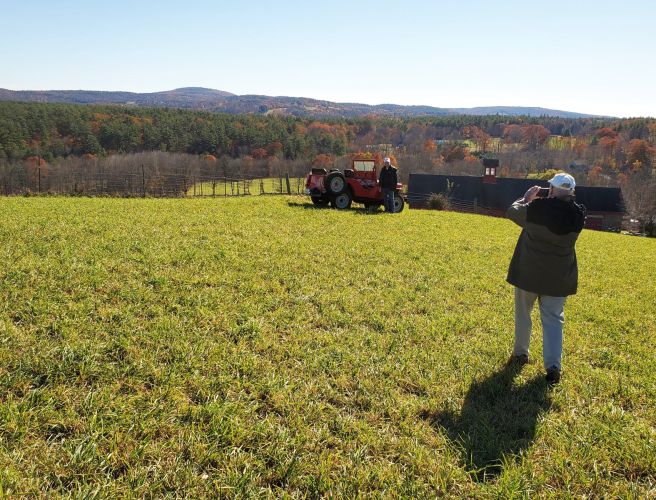
John takes a photo of his brother Tom on the hilltop with Jim's 1946 Jeep
